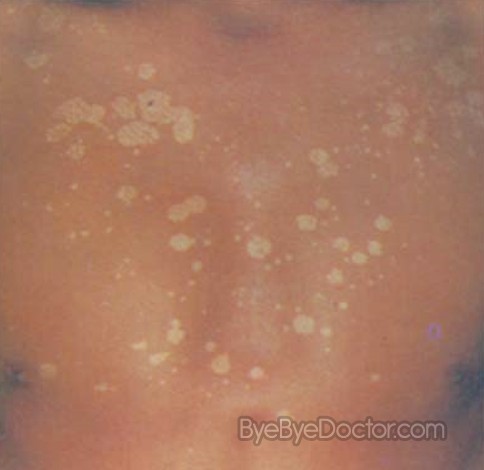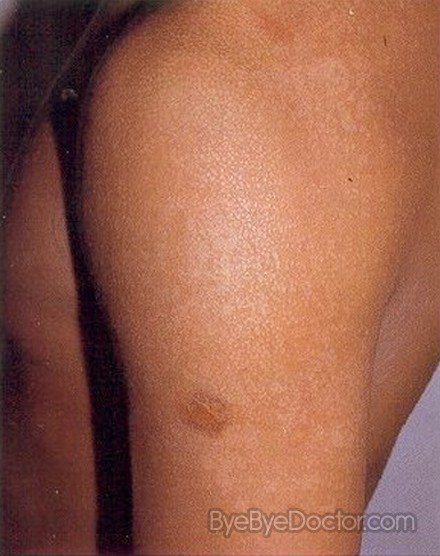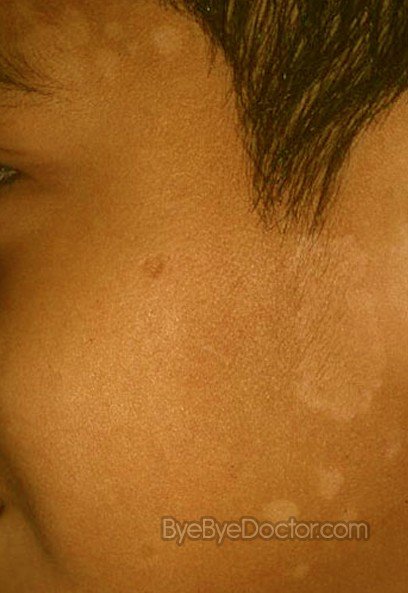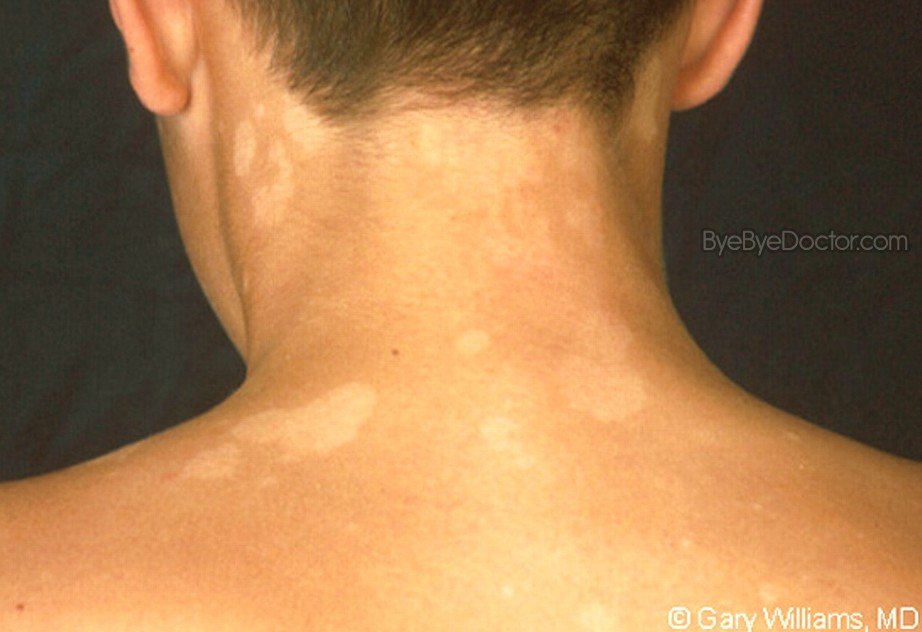Tinea Versicolor
Last reviewed by Dr.Mary on August 7th, 2018.
What is Tinea Versicolor?
This is a fairly common infection of the skin caused by a fungal infection. It is also sometimes referred to as pityriasis versicolor. This fungus hinders the normal pigmentation of the skin which results in discolored, small patches. These areas may be mildly itchy or flaky. The many spots which are small can blend into much larger patchy areas, generally on the oily areas of the upper body, for instance, the back or chest. These spots may be either darker or lighter than the surrounding area of skin around them.
Tinea versicolor is most frequent in young adults as well as teens. This is because these are the ages when individuals have the most problems with oily skin. Sun exposure can also make tinea versicolor more evident. This condition does not spread from person to person.
Antifungal creams, shampoos or lotions may help treat tinea versicolor. But even when there is a successful treatment, the skin color can remain uneven for many weeks until the repigmentation occurs and tinea versicolor may return, especially in humid, warm weather.
Tinea Versicolor Symptoms
The symptoms of this condition include flat, round, small, or oval spots that can in given time, form patches.
During the summer especially in mild climates, these spots can be very noticeable since they do not tan with the rest of the skin. During the winter, these spots can seem to go away as the summer tan fades as well as becoming less noticeable.
The symptoms and signs of this condition include:
- Scaly, small patches of skin which is discolored
- Patches which slowly grow
- Patches which tend to become more obvious after exposure to the sun
- Mild itching is possible
- Patches may be of various colors, including white, pink, tan and dark brown
Even though this discoloration can be very apparent on the skin which is dark, the infection may affect anyone regardless of skin color. Each person’s spots usually are just one color. The spotted skin can be scaly. Although it is not common, the skin can be itchy, especially when it is hot and humid.
This fungal infection is most common in humid, warm temperatures, and commonly affects these areas:
- Back
- Neck
- Chest
- Upper arms
Other things which can increase the chance of getting tinea versicolor include:
- Having an immune system which is impaired which may occur during pregnancy or from some other illnesses
- Using some medicines such as corticosteroids, birth control pills or antibiotics
- Less likely to happen as you age, when the skin starts becoming less oily
When to See the Doctor?
An individual should see the doctor if:
- The skin does not improve with measures of self-care
- The fungal infection returns
- The patches cover areas of your body which are large
Your physician can usually tell if you have tinea versicolor just by examining the spots. Further, they may diagnose the sample or scraping of the skin which is infected under a microscope.
Tinea Versicolor Causes
Healthy skin may normally have this fungus which causes this disorder growing in areas where hair follicles are opening onto the skin’s surface. Tinea versicolor occurs typically when this fungus for some reason becomes overgrown. There are numerous factors which can trigger this overgrowth, including:
- Humid, hot weather
- Oily skin
- Sweating excessively
- Hormonal changes
- Immunosuppression – when the immune system is not able to protect the body from this growth of fungus or yeast on the skin or elsewhere.
Tinea Versicolor Treatment
This infection is usually easy to treat with skin creams, solutions or shampoos. But not everyone chooses to get treatment.
If this infection is severe or if it covers very large areas of the body, does not get better with skin care or returns often, your primary care physician can prescribe pills which are antifungal. These antifungal pills may not be taken by some individuals, especially those with heart or liver conditions. You can get your blood tested so that your physician can make sure that your liver or kidneys are functioning properly.
Medications
Some medications used for tinea versicolor treatment include:
Topical
- Selenium sulfide 2.5% lotion
- Ciclopirox (Loprox) cream, lotion or gel
- Ketoconazole (Nizoral) shampoo or cream
Oral
- Ketoconazole (Nizoral) tablets
- Itraconazole (Sporanox) capsules
- Fluconazole (Diflucan) tablets
Even if the treatment is successful, the skin color can remain uneven for many weeks, or even months. And, the condition can return when the weather gets humid or warm. In really persistent cases, there is the possibility that the individual will need to take medication once or twice a month to prevent the fungal infection from returning.
For cases of tinea versicolor which are very mild, an individual can apply OTC or over the counter antifungal lotion, ointment, shampoo or cream. The majority of fungal infections respond well to topical agents, which include:
- Selenium sulfide shampoo – (Selsun Blue)
- Miconazole (Monistat-Derm)
- Clotrimazole (Lotrimin)
- Terbinafine (Lamisil)
Wash and dry the area which is affected. Then, apply a very thin layer of the topical agent once or twice a day for at the least two to three weeks. If you are using the shampoo, leave it in for 5 to 10 minutes before rinsing it out. If there is no improvement after four weeks, see your primary care physician as you may need stronger medication.
Tinea Versicolor Natural Treatments
There also are quite a few natural treatments for tinea versicolor that can be prepared at home. These treatments are particularly gentle and also will help to revitalize the skin. It has been suggested that several of these can be used as a regular skin program.
A body scrub can be made by grinding lightly about a handful of rice which is unpolished so that it will create flour which is coarse. You can then add several spoons of fresh tomato juice to this flour until a paste is made. Shower as normal and then use this special paste to apply all over the areas of the skin which are affected. Leave the paste to stay on the skin for 5 minutes and massage gently into the skin. Because tomato juice is acidic it prevents the fungus from spreading. The flour from the rice contains many nutrients which are considered important for healthy skin, and since it is also coarse, it serves as an exfoliating agent. You can also apply vinegar made from apple cider as this vinegar is also acidic and provides an environment which is hostile for the fungus to grow and therefore aids in controlling the spreading of the condition. While treating this condition using home treatments, it is very significant that you remember it will probably take some time for the skin to recover its original color.
Oil from a tea tree is an extremely powerful fungicide, and there are quite a few “tea tree oil” treatments which you can use to cure this condition. It’s essential to dilute this “tea tree oil” with a carrier oil before using it since “tea tree oil” is essential oil and has exceptionally strong natural composites. You should mix equal quantities of sweet almond oil, tea tree oil as well as olive oil and use the blend of oils following a shower rather than a moisturizing cream.
Prevention of Tinea Versicolor
Evade using oily products or oil on the skin or wear restrictive, tight or clothes which are non-ventilating. Exposure to the sun will make the infection more evident.
To help avert tinea versicolor from reoccurring, your primary care physician may prescribe an oral or topical treatment which can be taken 1 or 2 times a month. Other treatments for prevention include:
- Selenium sulfide (Selsun) lotion applied to areas every 2 to 3 weeks
- Itraconazole (Sporanox) capsules once a month
- Ketoconazole (Nizoral) tablets once a month
Tanning will cause the condition to become more visible so it should be avoided so that the change in color of the skin will be less noticeable.
Some physicians believe fungi can remain in clothing and can cause this infection to return. Regular cleaning and washing is usually effective in ridding the clothes of the fungi. But if the tinea versicolor is persistent, it is possible that you need to dry-clean the clothes or wash them in boiling water.
It is also believed that eating a healthy and balanced diet will also help to avert the returning of tinea versicolor. This diet contains foods which are very fresh, and it is best to stay away from foods which are processed as much as possible. Junk foods, as well as fried foods, can exacerbate these skin problems, so it is best to give them up totally until the skin has healed completely.
Make sure your diet also includes raw vegetables, raw fruits as well as whole grains. This reinforces the immune structure as these foods contain antioxidants. Excellent sources of antioxidants include tomatoes, citrus fruits as well as grapes. These foods also are rich in many vitamins.
Also, include fermented lactic acid foods such as yogurt as it has acidophilus which aids in keeping bacteria levels in balance and also aids in preventing infections to spread.
This diet should also avoid white flour as well as sugar. Pastries, as well as cakes, need to be avoided entirely. Garlic is an excellent antifungal agent which you can include in your list of foods.
Tinea Versicolor Pictures
 Pictures of Tinea Versicolor
Pictures of Tinea Versicolor
 Tinea Versicolor on arms
Tinea Versicolor on arms
 Tinea Versicolor on back
Tinea Versicolor on back
 on chest
on chest
 on face
on face
 Tinea Versicolor on neck
Tinea Versicolor on neck
 on Scalp
on Scalp
 on shoulders
on shoulders
hi…this is very good info…i felt i could find a natural cure for this skin disorder, and i do believe i have by reading this article…thanks!
This information has been very helpful. There is more information on here than my Doc could tell me. I was told to sit in the Sun!!! The Sun makes it look worse.
I m extremely derperate of this diseas…..coz i felt nothing when it came up in my body, its asymptomous so that I just feel health as normal.
Can’t counted how many Doc’s I’ve visited…around 10 doc’s but still it’s in my back, armpit and small in chest.
Many treatment that I’ve done with nizoral shampoo,selsun shampoo, mixed lanolin+locoid+benosonM, tar, hydrocortisone, aloevera, acyd salicyl,thio sulfas, and many more. but still it wont leave,… the Doc’s said actually the fungus were gone already but it leaves sign named hyppo.
Now I’ve that kinda Shebboroeic in my T face, my skin problem completely worst.
Does anyone here can help my prob? much thanks
@ Mom of two
Do u have it on your face? Mine us above my eyebrows using Noritate, just started.Please don’t tell me the discoloration doesn’t stay??? How long have u been treating it?
I have this around the areas of my private part. I find the pigmentation very ugly. It’s darker than the rest of my body. It really lowers my self esteem… How do i remove this pigmentation??? please help. I’m really desperate.. 🙁
Hi All, My 11 year old son has had Tinea Versicolor for 2 years now. It is more defined during the summer. His doctor recommended using Lotramin AF or any other anti fungal creme with Clotrimazole in it. I used the Lotramin and the white spots immediately disappeared after a few hours. I did not continue putting the creme on him once they disappeared and they came back after a month. When I took him back to the doctor she said that I should continue to use the creme even though it went away and make sure that he changes his shirt when he sweats. Apparently the sweating and heat is what causes it. I hope that helps you all. Good Luck!